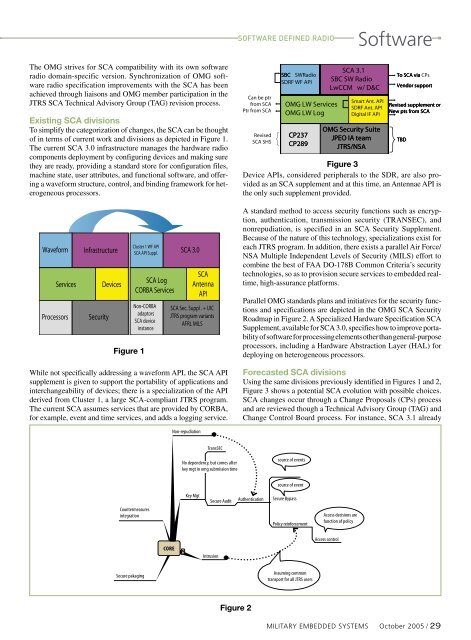Military Embedded Systems - Fall 2005 - Volume 1 Number 2
Military Embedded Systems - Fall 2005 - Volume 1 Number 2
Military Embedded Systems - Fall 2005 - Volume 1 Number 2
Create successful ePaper yourself
Turn your PDF publications into a flip-book with our unique Google optimized e-Paper software.
Software Defined Radio<br />
Software<br />
The OMG strives for SCA compatibility with its own software<br />
radio domain-specific version. Synchronization of OMG software<br />
radio specification improvements with the SCA has been<br />
achieved through liaisons and OMG member participation in the<br />
JTRS SCA Technical Advisory Group (TAG) revision process.<br />
Existing SCA divisions<br />
To simplify the categorization of changes, the SCA can be thought<br />
of in terms of current work and divisions as depicted in Figure 1.<br />
The current SCA 3.0 infrastructure manages the hardware radio<br />
components deployment by configuring devices and making sure<br />
they are ready, providing a standard store for configuration files,<br />
machine state, user attributes, and functional software, and offering<br />
a waveform structure, control, and binding framework for heterogeneous<br />
processors.<br />
Can be ptr<br />
from SCA<br />
Ptr from SCA<br />
Revised<br />
SCA SHS<br />
SBC SWRadio<br />
SDRF WF API<br />
OMG LW Services<br />
OMG LW Log<br />
CP237<br />
CP289<br />
SCA 3.1<br />
SBC SW Radio<br />
LwCCM w/ D&C<br />
Smart Ant. API<br />
SDRF Ant. API<br />
Digital IF API<br />
OMG Security Suite<br />
JPEO IA team<br />
JTRS/NSA<br />
Figure 3<br />
Device APIs, considered peripherals to the SDR, are also provided<br />
as an SCA supplement and at this time, an Antennae API is<br />
the only such supplement provided.<br />
}<br />
To SCA via CPs<br />
Vendor support<br />
Revised supplement or<br />
New pts from SCA<br />
TBD<br />
Waveform<br />
Services<br />
Processors<br />
Infrastructure<br />
Security<br />
Devices<br />
Figure 1<br />
Cluster 1 WF API<br />
SCA API Suppl.<br />
SCA Log<br />
CORBA Services<br />
Non-CORBA<br />
adaptors<br />
SCA device<br />
instance<br />
SCA 3.0<br />
SCA<br />
Antenna<br />
API<br />
SCA Sec. Suppl . + UIC<br />
JTRS program variants<br />
AFRL MILS<br />
A standard method to access security functions such as encryption,<br />
authentication, transmission security (TRANSEC), and<br />
nonrepudiation, is specified in an SCA Security Supplement.<br />
Because of the nature of this technology, specializations exist for<br />
each JTRS program. In addition, there exists a parallel Air Force/<br />
NSA Multiple Independent Levels of Security (MILS) effort to<br />
combine the best of FAA DO-178B Common Criteria’s security<br />
technologies, so as to provision secure services to embedded realtime,<br />
high-assurance platforms.<br />
Parallel OMG standards plans and initiatives for the security functions<br />
and specifications are depicted in the OMG SCA Security<br />
Roadmap in Figure 2. A Specialized Hardware Specification SCA<br />
Supplement, available for SCA 3.0, specifies how to improve portability<br />
of software for processing elements other than general-purpose<br />
processors, including a Hardware Abstraction Layer (HAL) for<br />
deploying on heterogeneous processors.<br />
While not specifically addressing a waveform API, the SCA API<br />
supplement is given to support the portability of applications and<br />
interchangeability of devices; there is a specialization of the API<br />
derived from Cluster 1, a large SCA-compliant JTRS program.<br />
The current SCA assumes services that are provided by CORBA,<br />
for example, event and time services, and adds a logging service.<br />
Forecasted SCA divisions<br />
Using the same divisions previously identified in Figures 1 and 2,<br />
Figure 3 shows a potential SCA evolution with possible choices.<br />
SCA changes occur through a Change Proposals (CPs) process<br />
and are reviewed though a Technical Advisory Group (TAG) and<br />
Change Control Board process. For instance, SCA 3.1 already<br />
Non-repudiation<br />
TransSEC<br />
No dependency, but comes after<br />
key mgt in omg submission time<br />
source of events<br />
source of event<br />
Countermeasures<br />
integration<br />
Key Mgt<br />
Secure Audit Authentication Secure Bypass<br />
Policy reinforcement<br />
Access decisions are<br />
function of policy<br />
Access control<br />
CORE<br />
N<br />
Intrusion<br />
Secure pakaging<br />
Assuming common<br />
transport for all JTRS users<br />
Figure 2<br />
<strong>Military</strong> EMBEDDED SYSTEMS October <strong>2005</strong> / 29
















